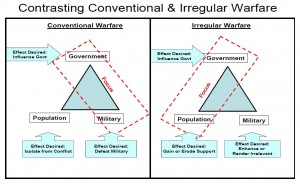“IW is a complex, ‘messy,’ and ambiguous social phenomenon that does not lend itself to clean, neat, concise, or precise definition.”
Irregular Warfare Joint Operating Concept, 2008
The above quote reflects the discomfort that the US military had (and continues to have) in coming to terms with an aspect of warfare that was becoming increasingly apparent in the wake of its struggles in Iraq and Afghanistan. While many were concerned that the military was gearing up to take on political objectives and employ political methods, there was a growing understanding that the “traditional” way of doing business was not working as well as might be hoped, and a growing number of voices arguing that these problems were not going to go away any time soon. So the Pentagon set out to try to come to grips with the problem, formulating a new doctrine of irregular warfare-often abbreviated to “IW”- to encompass the many interrelated issues that it was confronting.
Doctrinal definition of Irregular Warfare
Irregular Warfare is defined in US joint doctrine as “A violent struggle among state and non-state actors for legitimacy and influence over the relevant populations.” As such, it encompasses much of what has until recently been considered to be traditional warfare, since militaries have long understood that they must take public perception into account in their planning. However, it also includes areas of military operations that are not as well-known, and in fact seek to maintain that low profile. Such “special” operations are understood to be politically sensitive and thus often function best when their existence goes undetected. Complicating things further, according to this definition, irregular warfare also includes activities that are usually not considered to be the purview of the military, such as strategic communications, diplomatic activities, and other forms of political or cultural engagement.
Irregular Warfare and political violence
Being a “violent struggle,” IW does not seek to address the political maneuverings of those who do not and are not expected to employ force to achieve their goals. However, it does seek to address the employment of political methodologies of violent organizations. It is interesting to note the relationship of irregular warfare in this regard to traditional warfare, which seeks to address the violent methodologies of (formal) political organizations. This mirror image dichotomy exposes one of the key aspects of IW that should be understood by all military theorists and practitioners: irregular and traditional forms of warfare view the same basic problem from different perspectives: political violence. The following graphic, from the first Irregular Warfare Joint Operating Concept may help to illuminate this duality:
As opposite sides of the same coin, while each may be independently useful in a given situation, they are usually best used in some blended form based upon the scenario at hand. For example, IW tends to be of most use in dealing with non-state actors, when deniability is required, or when the instability to be addressed has its roots in popular unrest.
Core activities of Irregular Warfare
Because of this, current US military doctrine describes the five core activities of irregular warfare as counterterrorism, counterinsurgency, foreign internal defense, stability operations and unconventional warfare. These activities are highlighted not to limit the scope of IW, but because each necessarily involves the attempt to either bolster or undermine the legitimacy of a foreign government in the eyes of its own population, or some portion thereof. In fact, this could be considered a second definition of irregular warfare, albeit a more circumscribed one.
In future posts, we will return to these considerations again and again as we explore the many facets of irregular warfare.

2 thoughts on “Defining Irregular Warfare”